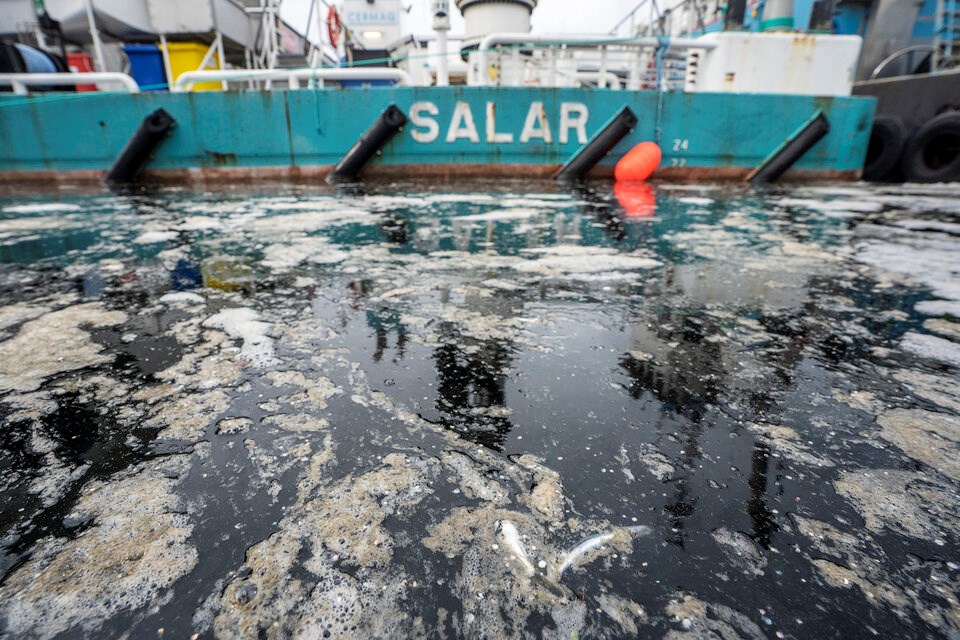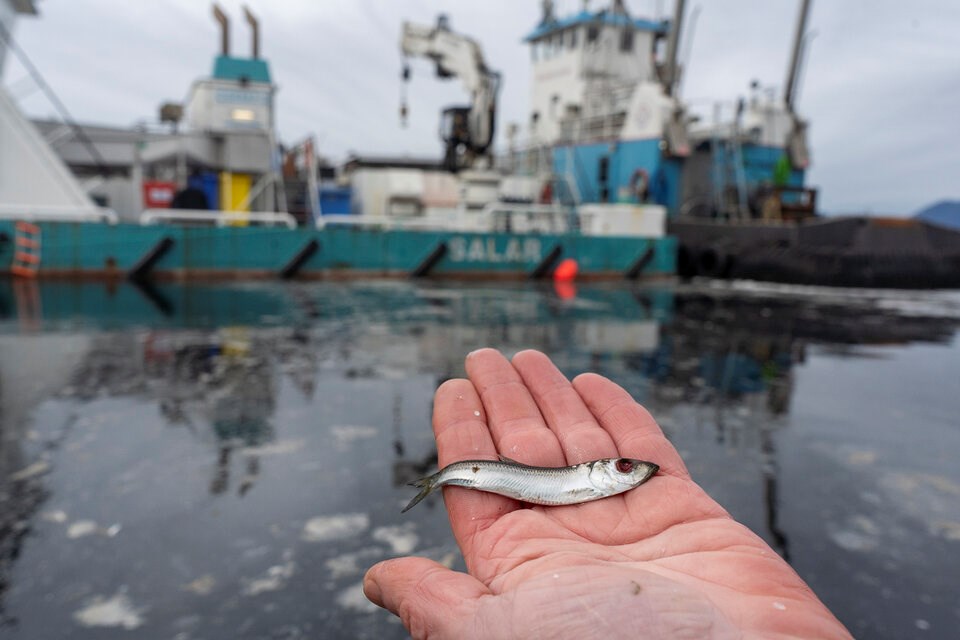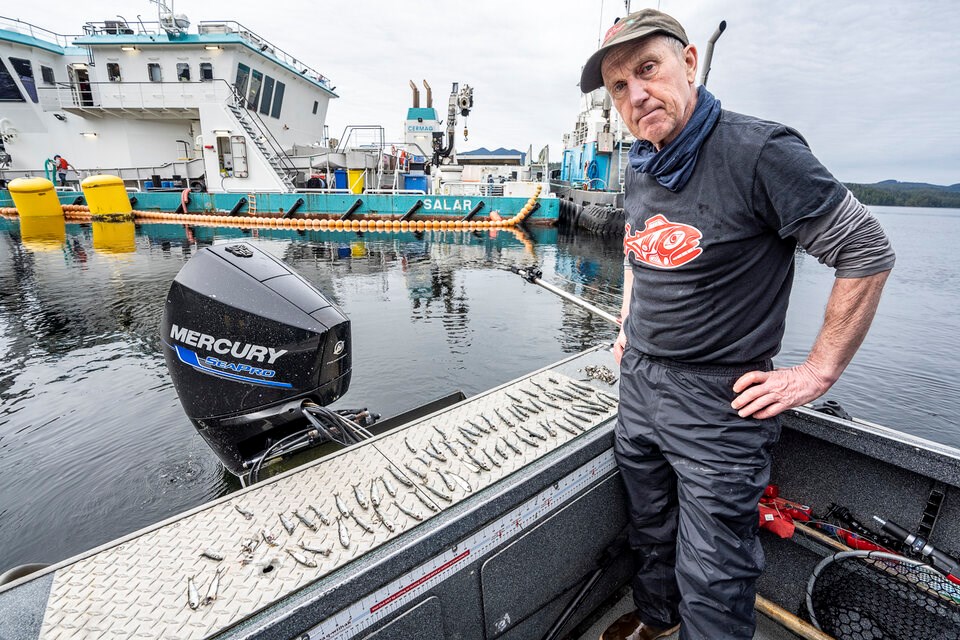B.C. salmon farms killed more than 800,000 wild fish in 2022, 16 times more than the last decade's yearly average, federal data shows.
The unprecedented spike in aquaculture bycatch accounts for more dead fish in one year than the combined death toll over the previous 10 years. It comes despite a federal decision to reduce the number of salmon farms in B.C. and transition the industry to something more sustainable by 2025.
In one graphic example, video captured at a Cermaq facility in Clayoquot Sound shows herring floundering at the surface after getting sucked into a powerful machine meant to remove sea lice from farmed salmon.
Stan Proboszcz, a senior scientist at Watershed Watch Salmon Society, said he has never seen anything like it.
“All these herring that went through the hydrolicer had their eyes blown out,” Proboszcz said. “It’s horrific.”
'I broke down and cried'
Dan Lewis, the executive director of Clayoquot Action, captured the video near Tofino on one of the group’s routine checkups. Lewis said he was expecting to see scum across the surface of the water due to the arrival of a barged-in hydrolicer.
The machine sucks up salmon through a giant hose and blast away sea lice using high-pressured water. The process can also remove the salmons’ mucosal layer, leaving a white residue on the surface. But that wasn't the only thing in the water, said Lewis.
“We were just on a routine inspection and we started to see little dead herring bubbling up out of the water,” he said.

Stunned at first, Lewis began scooping them up in a net, but they just kept coming. Juvenile fish not big enough to go through the hydrolicer had their eyeballs blown out because of the extreme pressure. Some were also covered in sea lice.
“Some of them were still twitching, they're still alive,” said Lewis. “It was devastating to witness that. I broke down and cried.”
Surge in fish kills come as herring struggle to recover
An estimated 90 per cent of wild fish killed in B.C. salmon farm operations are herring, according to Fisheries and Oceans Canada (DFO).
The fish are smaller than salmon, but occupy a foundational role in the ocean’s food web. Seals, sea lions, seabirds and a variety of marine fish rely on the herring as sustenance. In one critical chain of that web, herring feed chinook salmon, which in turn nourish endangered southern resident killer whales as their preferred food.
By 2021, the herring population on the west coast of Vancouver Island was in trouble, prompting the federal government to impose a near total closure of the fishery.
But less than a year later, the number of herring killed as bycatch in B.C. skyrocketed, jumping to 817,265 in 2022 from 169,705 the previous year, data shows.
Proboszcz said the spike in wild fish deaths suggests serious failures in the operation and oversight of salmon farms.
“To have nearly a million of these fish killed for no good reason, that's not cautious management. That's mismanagement,” added Lewis.
In an email, DFO spokesperson Kathryn Hallet said the incidents led the ministry to implement new conditions of licence in March 2023 “to ensure that sea lice treatments do not cause this type of impact on wild fish.”
Those conditions also require industry to more frequently report any treatments that involve wild fish.
Hallet said DFO has increased unannounced inspections of hydrolicing vessels and that no other “incidents of this nature” have been reported or observed since 2022.
DFO created playbook for 'significant negative attention' from the press
Alongside the data, 974 pages of internal communications, obtained by Watershed Watch Salmon Society through public record requests, show DFO staff raised concerns over the high number of fish kills in the summer of 2022.
In an Aug. 2 email to her communication staff, DFO’s manager of strategic issues, Kirsten Lawrie, warned that the incidents were “expected to draw significant negative attention.”
Documents indicate Cermaq provided DFO with a delayed analysis showing multiple events led to roughly 850,000 dead herring over 2021 and 2022.
By changing its procedures to control parasites, Cermaq “directly contributed to an increase in incidental catch and mortality,” reads the email.

In a briefing titled “Media Lines, Cermaq Canada Herring Mortality,” DFO managers can be seen creating a playbook to prepare for questions from the press.
Staff were directed to tell the news media that DFO is “reviewing wild fish mortalities” and “conducting inspections of vessels” connected to the hydrolicing.
Another talking point calls on staff to tell reporters, that according to DFO’s Aquaculture Management Division, the fish kill is “not likely to result in population-level harm.”
Lewis said that conclusion is based on numbers that could be way off as nobody appeared to count the dead herring he found. Just as important, he said, a dead herring could mean one fewer fish for other species that rely on them.
“They're an important forage fish. And so somebody was deprived of 800,000 herring to eat," Lewis said. “And that's going to have an impact on the ecosystem.”
Cermaq taking 'immediate action' but critics worry fish toll will climb
Since 2019, the Canadian government has spent roughly $39 million on managing aquaculture in B.C., and another $51 million on transitioning away from open-net pen salmon farming, documents show.
In the government's push to sever the transmission of sea lice and other pathogens to wild salmon, it's unclear what has been achieved so far. The 2022 spike in fish deaths in Clayoquot Sound offers a glimpse of the challenges facing the aquaculture industry.
In an email, a Cermaq spokesperson said the incidental fish kill Lewis filmed in 2022 was the result of “a significant shift in innovative technology” deployed to manage sea lice levels and live up to its agreement with the Ahousaht First Nation.
Cermaq’s Liz Crum said bycatch numbers were typically low. But in 2022, the company “experienced unusually high numbers of incidental catch in the nets, and struggled to manage the sheer number of herring,” something she attributed to the “generally large numbers” of herring in the area.
She said the company is working on reducing bycatch by updating its operating procedures and swapping out certain kinds of nets that allow herring into the farms. As a result, Crum said bycatch has dropped significantly in 2023.

Meanwhile, Cermaq appears to have faced few consequences for the fish kills in Clayoquot Sound.
In August 2022, DFO management instructed staff to tell reporters that bycatch management and reporting “raise a number of non-compliance concerns” and that the incidents are currently under investigation by conservation and protection fishery officers.
Staff should also highlight that to protect wild fish, the division “is taking immediate action to review and consider changes to conditions of licence.”
But Cermaq’s Crum said the changes to the conditions of licence that occurred shortly after the incident “were not specifically related.”
“There are no penalties associated with fisheries bycatch, either in finfish aquaculture or commercial fishing,” Crum said.
For Lewis, a lot of questions remain unanswered. Eight hydrolicers work up and down the B.C. coast and he worries that what he witnessed in Clayoquot Sound “was just the tip of the iceberg.”
“That number could be much higher,” Lewis said. “We don’t know.”




